Under the curation of Katerina Gregos, Riga’s first biennial RIBOCA – which runs until 28 October – has a strong Baltic focus, with over half of the artists coming from the region. Titled Everything Was Forever, Until It Was No More, after Alexei Yurchak’s book of the same name, the event features more than 100 artists, including 10 collectives, who engage with how we anticipate, experience and adapt to change, particularly during this time of rapid technological advances. The title of the show, however, points to the unreliable nature of change. In particular, the biennial considers how moments of transition and transformation affect our bodies, psyches and behaviours. Significantly, of the 113 works on show, 49 are new commissions.
Drawing on Latvia’s rich architectural heritage, the biennial is spread across eight main sites, including the former Faculty of Biology and Bolshevichka textile factory. Despite its ambitious scope, the biennial feels manageable and coherent, in part thanks to Gregos’s creation of a route divided by thematic chapters. The route ends at the modernist Dulbuti railway station with The Sensorium: A Laboratory for the Deceleration of Time and a New Politics of the Senses, curated by Solvej Helweg Ovesen.
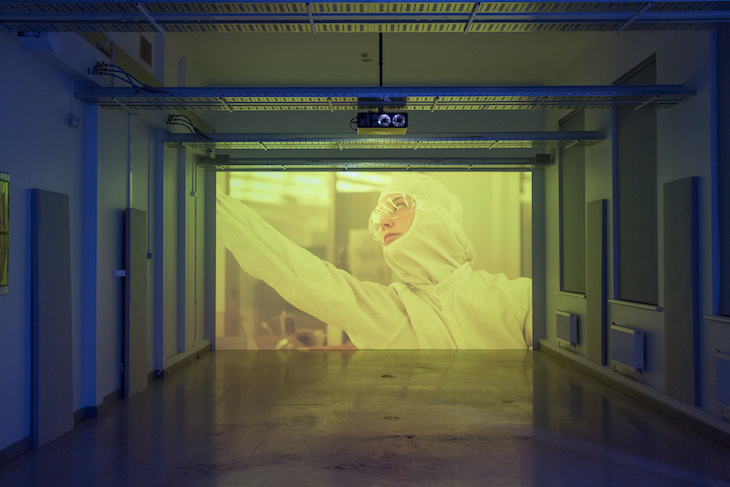
Installation view of Zero Point Energy (2016) by Kerstin Hamilton at RIBOCA, 2018. Photo: Vladimir Svetlov; courtesy of the artist
Concerns about the speed of change, scientific intervention, optimisation of the human body and self-extinction recur in the biennial. In our quest to control technology, nature and even our own human condition, we may in fact be dominated in return. In her video Zero Point Energy (2016), Kerstin Hamilton examines the field of nano research, exposing man’s desire to stretch the limits of knowledge. Her text-based photographs, A World Made by Science (2018), further investigate the challenges raised by fast-track scientific advances, as does Emilija Škarnulytė’s slow-paced video Mirror Matter (2018), which attempts to reveal the memories stored in technological facilities dealing with particle acceleration, such as Japan’s Super-Kamiokande neutrino observatory or CERN’s Large Hadron Collider.
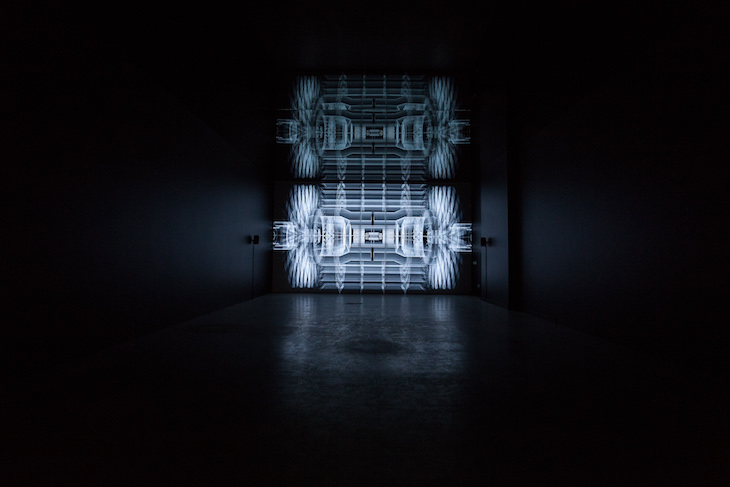
Installation view of Mirror Matter (2018) by Emilija Škarnulytė at RIBOCA, 2018. Photo: Vladimir Svetlov; courtesy of the artist
As the dream of mastering every aspect of human life becomes more real, progress itself comes into question: won’t we lose control over the cutting-edge technologies we have created? What impact will the rise of Artificial Intelligence (AI) have? The installations I Don’t Know You, So I Can’t Love You (2018) by Marge Monko, and Encyclopedia (2015–17) by Johannes Heldén and Håkan Jonson address this. The former asks whether smart assistant devices, such as Siri or Alexa, can form emotional bonds, mirroring our digitally created social interactions; the latter meditates on the possibility that AI might one day be seen as a new species. Similarly futuristic, Julian Rosefeldt’s haunting drone-film, In the Land of Drought (2015–17), features an army of scientists in decontamination suits rummaging through the remnants of civilisation after humanity’s extinction.
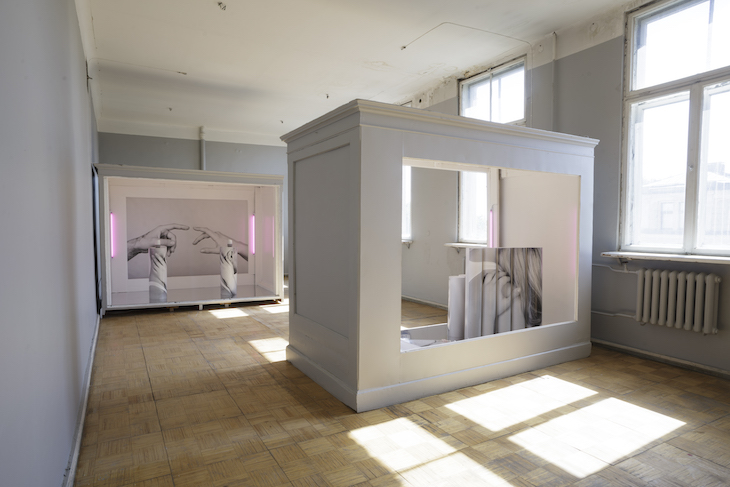
Installation view of I Don’t Know You, So I Can’t Love You (2018) by Marge Monko at RIBOCA, 2018. Photo: Andrejs Strokins; courtesy of the artist and Ani Molnar Gallery, Budapest
Climate change is also a topic under scrutiny throughout the biennial. The fast pace of sea level rise and melting ice is made palpable in the cracking and liquid noises of Jacob Kirkegaard’s sound installation MELT (2016). Despite the depiction of lush vegetation in A World in Waiting (78°14’08.4”N 15°29’28.7”E) (2017), a magnificent collaborative tapestry by Finnish artists IC-98 and Kustaa Saksi, the work imagines the place where Svalbard Global Seed Vault once stood, showing seeds sprouting after unprecedented ecological disaster.
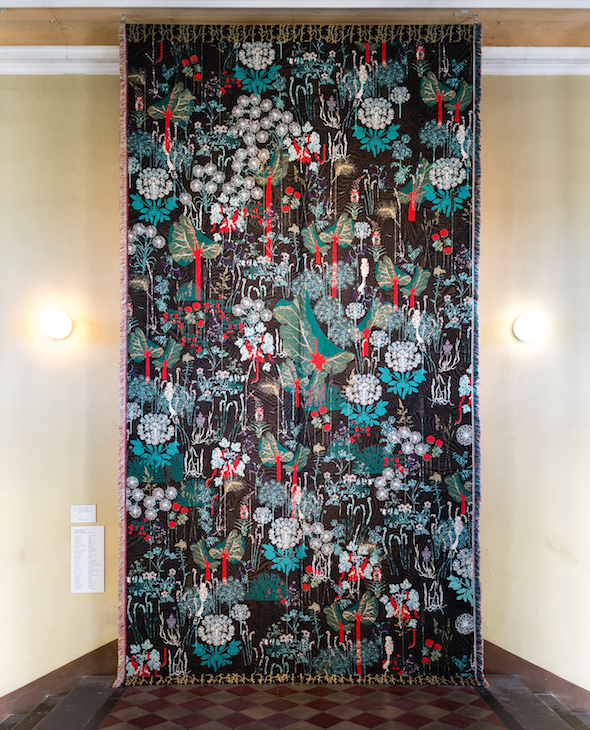
Installation view of A World in Waiting (78°14’08.4″N 15°29’28.7″E) (2017) by IC-98 and Kustaa Saksi at RIBOCA, 2018. Photo: Vladimir Svetlov; courtesy of the artists
The rate of technological and digital advancement, which serves to shift our conception of time, generates a range of human emotions – from anxiety and vertigo to fear of exclusion – and requires endless adaptability. Our obsession with ‘keeping up’ induces compulsive behaviour and guilt whenever we fail to ‘deliver’. Taus Makhacheva’s immersive installation Dear R., R., K., S., M., A., C., S., K., I., G., L., A., A., L., P., G., E., J., D., M., C., B., O., F., F., R., D., M., E., L., I., F., L., A., M., T., K., K., L., P., F., V., A., L., L.. (2018), which features a number of portable speakers out of which come the voices of people apologising for their late email responses, effectively recreates such feelings of alienation. Danilo Correale’s print work Fivehundredfortyeight (2015), an index of data and statistics, clearly deals with the idea of fatigue.
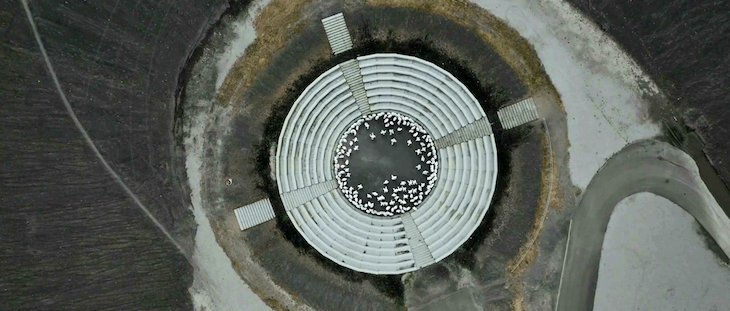
Installation view of In the Land of Drought (2016) by Julian Rosefeldt at RIBOCA, 2018.
Photo: Vladimir Svetlov; © Julian Rosefeldt and VG Bild-Kunst, Bonn 2018
Several works in the biennial also consider human interactions across the centuries. Kristaps Epners’ installation Forget Me Not (2018), based on the correspondence between his father and Latvian poet Miervaldis Kalniņš, celebrates the sincerity and integrity found in friendship. Since 2011, Sasha Huber and Petri Saarikko have been recording natural healing techniques shared orally and over generations. Dziedināšana Remedies (2018) was commissioned especially for RIBOCA and investigates the local pirts tradition – a physical and spiritual cleansing sauna culture. In Riga, they collected caring recipes, along with lullabies and charms of medicinal value.

Installation view of Fivehundredfortyeight (2015) by Danilo Correale at RIBOCA, 2018. Photo: Vladimir Svetlov; Courtesy of the artist and Galleria Raucci/Santamaria, Naples
Considering the curatorial conceit, it would have been useful to see a more sustained engagement with works dealing with knowledge-transfer or the transmission of knowledge in transitional circumstances. Stine Marie Jacobsen’s Pidgin Tongue (2018), however, a fascinating installation and book based on a workshop conducted with children from Riga around language, deconstructs the participants’ Latvian and Russian mother tongues to invent a hybrid communication system. Further reflections on the unpredictability of change are also missing: futurology fails to anticipate the mistakes or anomalies that might occur in future developments. That said, the first edition of the biennial kicked off under favourable auspices. Everything Was Forever, Until It Was No More succeeds in transmitting an accurate feeling of our contemporary moment.
Riga International Biennial of Contemporary Art (RIBOCA) runs until 28 October.
Unlimited access from just $16 every 3 months
Subscribe to get unlimited and exclusive access to the top art stories, interviews and exhibition reviews.


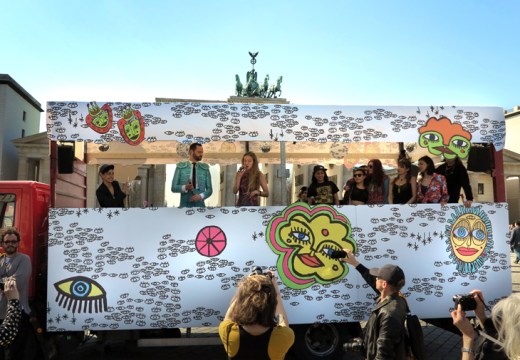
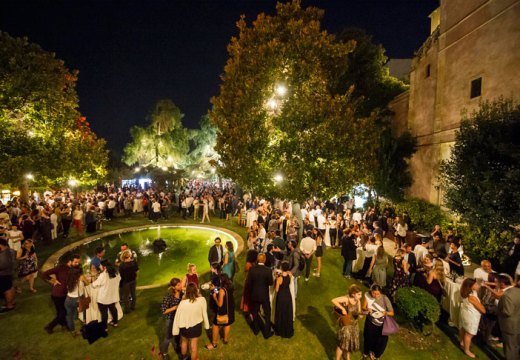
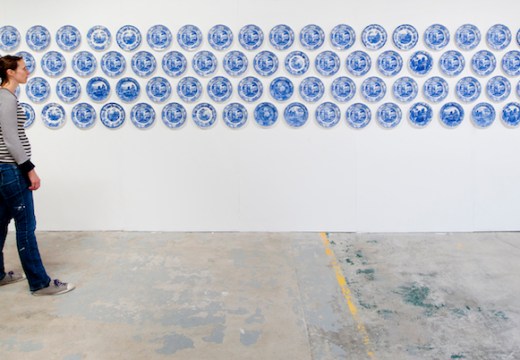









![Masterpiece [Re]discovery 2022. Photo: Ben Fisher Photography, courtesy of Masterpiece London](http://www.apollo-magazine.com/wp-content/uploads/2022/07/MPL2022_4263.jpg)
Has the Fitzwilliam lost the hang of things?